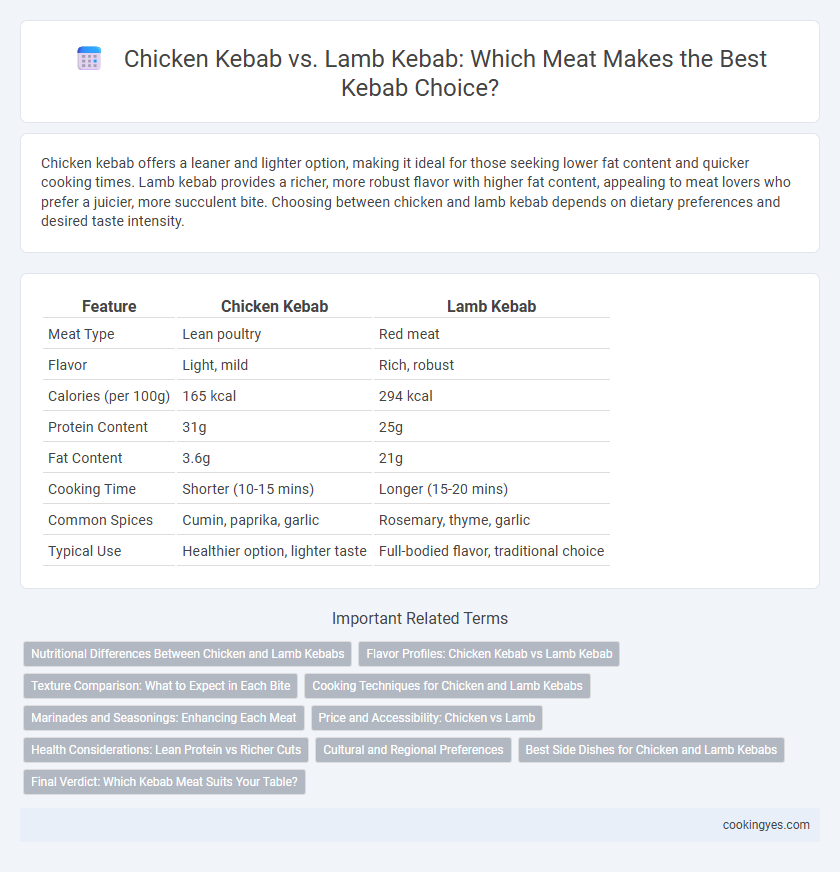Chicken kebab offers a leaner and lighter option, making it ideal for those seeking lower fat content and quicker cooking times. Lamb kebab provides a richer, more robust flavor with higher fat content, appealing to meat lovers who prefer a juicier, more succulent bite. Choosing between chicken and lamb kebab depends on dietary preferences and desired taste intensity.
Table of Comparison
| Feature | Chicken Kebab | Lamb Kebab |
|---|---|---|
| Meat Type | Lean poultry | Red meat |
| Flavor | Light, mild | Rich, robust |
| Calories (per 100g) | 165 kcal | 294 kcal |
| Protein Content | 31g | 25g |
| Fat Content | 3.6g | 21g |
| Cooking Time | Shorter (10-15 mins) | Longer (15-20 mins) |
| Common Spices | Cumin, paprika, garlic | Rosemary, thyme, garlic |
| Typical Use | Healthier option, lighter taste | Full-bodied flavor, traditional choice |
Nutritional Differences Between Chicken and Lamb Kebabs
Chicken kebabs provide a leaner protein source with lower saturated fat content, making them ideal for heart health and weight management. Lamb kebabs offer higher levels of iron, zinc, and vitamin B12, essential for red blood cell production and immune function. Choosing between chicken and lamb kebabs depends on dietary needs, with chicken favoring low-fat nutrition and lamb delivering more micronutrients.
Flavor Profiles: Chicken Kebab vs Lamb Kebab
Chicken kebab offers a mild, slightly sweet flavor with tender, juicy meat that easily absorbs marinades featuring herbs like thyme, garlic, and lemon. Lamb kebab presents a richer, gamey taste with robust, fatty textures that pair well with strong spices such as cumin, coriander, and smoked paprika. The flavor profiles influence pairing choices, as chicken kebabs suit light side dishes and fresh salads, while lamb kebabs complement hearty grains and bold sauces.
Texture Comparison: What to Expect in Each Bite
Chicken kebab offers a tender and juicy texture with a slight firmness that easily absorbs marinades, resulting in a flavorful and succulent bite. Lamb kebab provides a richer, denser texture with a chewier consistency, offering a more robust and hearty mouthfeel due to its higher fat content. Each bite of chicken kebab delivers a lighter, delicate experience, while lamb kebab satisfies with a bold, textured savoriness.
Cooking Techniques for Chicken and Lamb Kebabs
Chicken kebabs require careful marination with acidic ingredients like yogurt or citrus to tenderize the lean meat, and are typically cooked over medium heat to prevent dryness. Lamb kebabs benefit from longer marination with robust spices and are best grilled over high heat to achieve a charred exterior while retaining juiciness. Both meats demand precise timing and heat control to optimize flavor and texture during grilling.
Marinades and Seasonings: Enhancing Each Meat
Chicken kebab marinades often feature yogurt, lemon juice, garlic, and spices like cumin and paprika to tenderize and impart a bright, tangy flavor profile. Lamb kebabs benefit from robust seasonings such as rosemary, garlic, oregano, and a blend of warm spices like cinnamon and coriander that complement the meat's rich, gamey taste. Both marinades emphasize enhancing texture and aroma, with chicken leaning towards light, citrusy notes and lamb embracing deeper, earthier herbaceous elements.
Price and Accessibility: Chicken vs Lamb
Chicken kebab is generally more affordable and widely accessible than lamb kebab due to lower production costs and higher supply. Lamb kebab tends to be pricier and less available, often considered a premium option with richer flavor. Consumers seeking budget-friendly kebab options typically opt for chicken, while lamb is favored for special occasions or gourmet experiences.
Health Considerations: Lean Protein vs Richer Cuts
Chicken kebab offers a lean protein option with lower saturated fat and fewer calories, making it ideal for heart health and weight management. Lamb kebab, rich in iron, zinc, and vitamin B12, provides essential nutrients but contains higher saturated fat that may impact cholesterol levels. Choosing between chicken and lamb kebab depends on balancing lean protein benefits with the richer nutrient profile of lamb.
Cultural and Regional Preferences
Chicken kebab and lamb kebab reflect distinct cultural and regional preferences that shape their popularity and preparation methods. In Middle Eastern and Mediterranean regions, lamb kebab is often preferred for its rich flavor and traditional significance in festive meals, while chicken kebab is favored in South Asian and urban Western cuisines for its lean protein and versatility. The choice between chicken and lamb kebab also aligns with dietary customs and religious practices, with lamb being more prominent in halal celebrations and chicken offering a milder alternative suitable for diverse palates.
Best Side Dishes for Chicken and Lamb Kebabs
Chicken kebabs pair exceptionally well with light and refreshing sides such as cucumber yogurt salad, grilled vegetables, and lemon rice, enhancing the tender and mild flavor of the poultry. Lamb kebabs benefit from robust accompaniments like spiced couscous, roasted potatoes, and tabbouleh, which complement the rich, gamey taste of the meat. Selecting sides that balance the protein's intensity maximizes the overall dining experience for both chicken and lamb kebab enthusiasts.
Final Verdict: Which Kebab Meat Suits Your Table?
Chicken kebab offers a leaner, lighter option rich in protein and lower in fat, making it ideal for those seeking a health-conscious yet flavorful meat choice. Lamb kebab, known for its robust, juicy flavor and higher fat content, delivers a richer taste experience favored in traditional Middle Eastern and Mediterranean cuisines. Your final verdict should consider dietary preferences, flavor intensity, and cooking method, with chicken kebab suiting lighter meals and lamb kebab excelling in heartier, spice-forward dishes.
Chicken Kebab vs Lamb Kebab for Meat Choice Infographic

 cookingyes.com
cookingyes.com